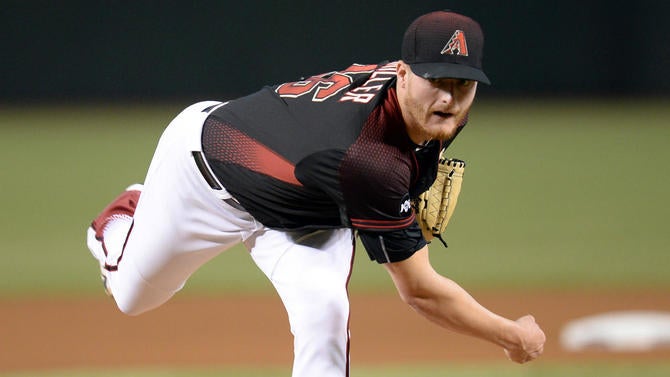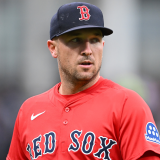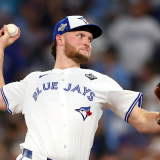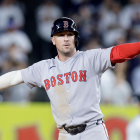
D-Backs could win the World Series this year if they can just win the Wild Card Game
Why the Diamondbacks could be the team to turn this October on its head in MLB
If you had to describe the state of the Arizona Diamondbacks following their 69-win debacle of 2016, extremely-not-nice would've been a good place to start.
The D-Backs finished third-worst in the majors in park-adjusted ERA and fourth-worst in park-adjusted, fielding-independent pitching. Less than 24 hours after they played their final game of the season, they fired general manager Dave Stewart and manager Chip Hale. Stewart had impulsively stripmined the farm system in a desperate attempt to right the ship, trading away Gold Glove-caliber center fielder Ender Inciarte and a phalanx of valuable prospects, led by 2015 No. 1 overall pick Dansby Swanson. If the team's present looked bleak, its future looked downright futile.
Fast forward one year, and the Diamondbacks look like a completely different team. The third-worst pitching staff in baseball last year by park-adjusted ERA is now the second best -- and fielding-independent numbers back up that newfound excellence. Vastly improved run production begets vastly improved results: The 2017 D-Backs own the third-best record in the National League, and are on pace to deliver their best season since the division-winning 94-68 club of 2011.
You might assume, based on the gigantic scope of the Diamondbacks' turnaround, that management overhauled the roster in a dramatic way. But that's not the case. Though Arizona has benefited from a handful of offseason moves (and one of the greatest deadline deals of the decade), the core of this year's team looks strikingly similar to the fourth-place also-rans who wore the same uniforms last year.
"I'd say the talent level was pretty good at the major-league level," GM Mike Hazen said, referencing the roster he inherited when he took over the lead baseball ops role last fall. "You had [Zack] Greinke who has Cy Young stuff, Robbie Ray with elite stuff, Patrick Corbin was an elite starter a couple years ago before having Tommy John. And Shelby Miller, who had been an elite starting pitcher in the NL. We felt pretty good at the talent that was on the team," despite the awful run-prevention numbers of 2016.

Seeing all that pitching talent on the major-league roster, with some more in the high minors, Hazen and top lieutenants Jared Porter and Amiel Sawdaye decided against breaking the bank for a star free-agent arm. They did make one major trade, bringing in talented young right-handed starter Taijuan Walker as part of a five-player swap with the Mariners. But other than that, their biggest offseason pitching buys were veterans Fernando Rodney, Jorge de la Rosa and J.J. Hoover, all on one-year deals, for less than $6 million combined. While the three vets would add depth to the bullpen and Walker would lend innings and upside to the rotation, the Diamondbacks were still going to have to sink or swim primarily with pitchers already in the organization.
Two of those pitchers got a jolt of education months before Hazen, Porter and Sawdaye took over the baseball ops division, and before Torey Lovullo replaced Hale as the D-Backs new manager. In January 2016, pitching coach Mike Butcher invited three young pitchers, Ray, Archie Bradley and Rubby De La Rosa, to get a head start on spring training. All three hurlers had dynamic stuff, but all three still needed plenty of work if they were going to become polished big leaguers.
"We worked on refining their deliveries, add pitches in some cases, subtract pitches in others," Butcher said. "I really wanted them to understand their delivery, how to use their stuff, which quadrants of the zone to pitch in. We had a few guys who didn't repeat their delivery as well as you'd like to see at the major level, so we needed to address that especially."
The results slowly started to shine through. Originally a 12th-round pick by the Nationals in 2010, Ray bounced to the Tigers organization before landing in Arizona after the 2014 season. In his new home in the desert, Ray started pumping his fastball into the mid-90s with regularity, and also refined his nasty slider. Then in 2016 he developed into one the most devastating strikeout pitchers of the league -- but also walked too many batters and allowed far too much hard contact. Bradley was Ray's right-handed counterpart, getting his first extended look in the majors, whiffing more than a batter an inning but also struggling with his command, resulting in both too many free passes and too many hittable pitches over the meaty part of the plate. (Injuries would sadly wipe out much of 2016, and '17, for De La Rosa.)
While Ray and Bradley suffered through those growing pains even as they started to harness their talent, something curious was happening to more established pitchers on the roster. After a season for the ages with the Dodgers in 2015, Greinke suddenly looked mortal with the D-Backs the following year, as his ERA ballooned by nearly three runs. Miller went from borderline ace material in Atlanta to an ugly 6.15 ERA with the Snakes. Pitcher after pitcher, starters and relievers, badly underachieved last year.
Assessing what went wrong upon their hire, a few weeks after season's end, the Diamondbacks' new braintrust started noticing a pattern.
"Injuries," Lovullo said. "You had key injuries to key players in the outfield in A.J. Pollock and David Peralta. Then they had to move infielders out of their normal positions to try to cover those holes. You do that in a couple of different spots and it starts to add up. Pitching and defense always go hand in hand."
The numbers bore out those suspicions. No team in 2016 converted fewer balls in play into outs than did the Diamondbacks.
Here again, Hazen and company opted not to overreact. If Pollock and Peralta could stay healthy for the better part of the season, that outfield defense problem would largely resolve itself. Still, the D-Backs scooped up veteran outfielder Gregor Blanco for insurance, figuring that if an outfield injury did strike again, they would have a reliable fly-chaser to step into the breach.
The final step in the team's offseason run-prevention plan was to get better defensively behind the plate. "It was a defense-first position for us," Hazen said. "We decided we won't care about offense."

The D-Backs landed Jeff Mathis, an offensively limited catcher whose stellar defensive reputation can now be more easily seen with the proliferation of pitch-framing and other advanced defensive stats. Arizona also picked up Chris Iannetta, a defensively sound catcher who actually does deliver offense, in the form of power and a patient approach at the plate. With Mathis, Iannetta and incumbent Chris Herrmann on board, Hazen saw an unorthodox path that could pay dividends for both the catching corps and the team's pitching staff. "We went away from the one-catcher model, specifically for health and workload reasons. We wanted to keep them fresh, and give each of them more time to better prepare."
If 2016 was the season in which everything seemed to go wrong for the Diamondbacks pitching staff, 2017 has been the year for nearly everything to go right. Arizona did lose Miller for the year to Tommy John surgery but that injury merely created an opportunity.
Pitching as a full-time starter for the first time in the big leagues, Zack Godley has filled the Miller role brilliantly, riding a devastating curveball and a sinker-cutter combination to a tidy 3.20 ERA, with 158 strikeouts in 149 innings. The other pitcher the D-Backs considered to fill the Miller vacancy was Bradley. But the addition of Walker, combined with a slight lean toward Godley as a starter, prompted the Diamondbacks to move Bradley to the bullpen. That has proved to be one of the most inspired moves by any team this season. Working as Rodney's setup man and also as an occasional multi-inning threat in the mold of Andrew Miller, Bradley has been a beast, punching out 75 batters in 67 2/3 innings, with a microscopic 1.20 ERA.
Meanwhile, the combination of better defense, more experience and refinement and just simple regression toward the mean has boosted the rest of the staff. Ray has become a brutal matchup for hitters, emerging as both the second-most prolific strikeout artist among all National League starters while also riding what Butcher calls a more repeatable delivery and better tempo into much better command of all his pitches, and thus a lower walk rate. Rodney has shrugged off a volatile start to the season to post a 2.95 ERA over the past two months, with only rare blowups on his recent résumé. Corbin is back, fully healthy, and producing better-than-average results by both standard run-prevention and defense-independent metrics. As for Greinke, Year 2 in Arizona has been a gem. He has been especially lethal lately, with a 1.56 ERA and an opponents' batting line of .182/.208/.289 over his past five starts.
The difference? According to pitching analyst Nick Pollack of PitcherList.com, we can trace a lot of Greinke's improvement to a four-seam fastball that he started throwing lower in the zone, leading to fewer home runs hit against him. That improved fastball location better sets up his other pitches, and the result has been higher whiff rates on his slider and changeup. And in yet another sign that even the most established veteran stars can improve, Greinke has had a more consistent release point than what he showed in 2016.
Whether it's an old pro like Greinke or his younger staff mates, all have benefited from more refined pregame strategy sessions than what the team offered in the past. Butcher works closely with the D-Backs' three catchers, who then huddle with each day's starter. All of the above get feedback from a new, expanded group of advisers that includes Dan Haren and Burke Badenhop, two whip-smart, recently retired pitchers who offer feedback that can sometimes get missed in the heat of the moment from the dugout. The goal? To deliver a flurry of valuable information that's also easy to understand, and so concise that it can be crammed onto one sheet of paper.
In addition to those pitching and defensive improvements (+1 as a team per Baseball Info Solutions' Defensive Runs Saved last year, +26 this year, with stark improvements at catcher and the corner outfield spots), the D-Backs also boast a lethal offense. Perennial MVP candidate Paul Goldschmidt led the charge for much of the season, and ranks sixth among all NL hitters in park-adjusted offense. But even the mighty Goldy has taken a backseat lately to J.D. Martinez. In exchange for three prospects not ranked on any major lists, the D-Backs acquired a player who has already set a record for most Player of the Week awards in one season (four). As a Diamondback, Martinez has slugged a mind-boggling .711, launching 24 homers in just 53 games.
Add it all up and you have a team with no major weaknesses. The middle of the lineup has gone from good to terrifying thanks to the addition of Martinez. The rotation is one of the deepest in the league, and features two ace-caliber starters in Greinke and Ray. And while Rodney's history of making things interesting in the ninth could become an issue at some point, starters going deep into games, combined with Bradley's dominance, could help render that point nearly moot on multiple October nights.
The one-and-done nature of wild-card play-in games makes the Diamondbacks a candidate to hit the golf course early. If Arizona can win that one game, though, look out. Most of the names on the back of the jerseys haven't changed. But after a lost 2016 campaign filled with disappointment, these snakes now pack a helluva bite.


















